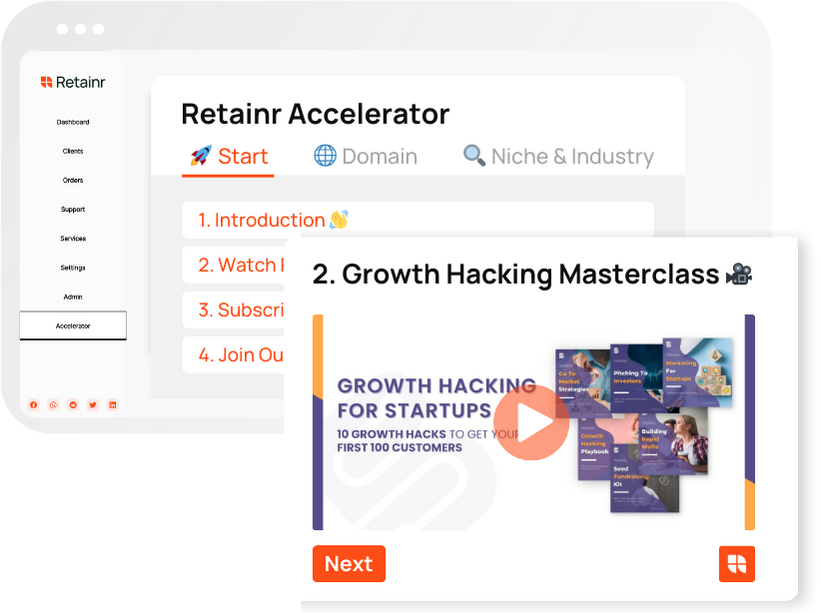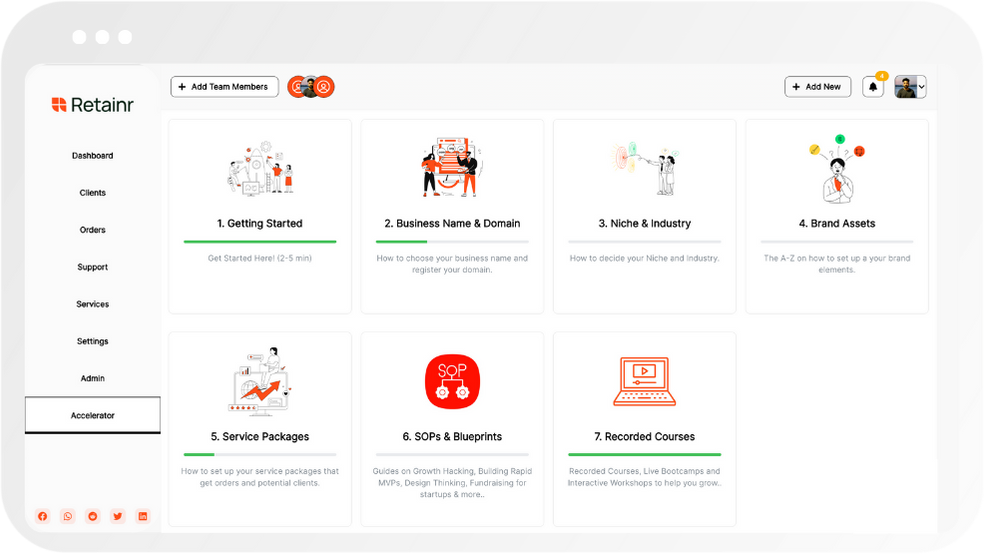
Checklist to Start an E-Commerce Business in 2024
Build with Retainr
Sell your products and services, manage clients, orders, payments, automate your client onboarding and management with your own branded web application.
Get Started1. What are the key elements to consider in the checklist to start an e-commerce business in 2024?
1. Business and Legal Framework
The first stage in starting an e-commerce business is setting up the right framework for your business. The basics include:
- Deciding on your business name and registering it
- Acquiring an EIN (Employer Identification Number) for tax purposes
- Choosing the best legal structure for your business (LLC, Corporation, etc.)
- Obtaining the necessary business licenses and permits
- Setting up a business bank account
Apart from these, you also need to terms of service and privacy policy for your online store. These legal documents are crucial for ecommerce businesses as they outline how you conduct business, protect your customers' rights, and comply with online commerce laws.
2. Product Selection & Stocking
Secondly, you have to decide what products you will sell and how you will manage your inventory. The key concerns under this stage are:
| Identifying your niche market | Understanding what products or services are in demand in your chosen niche market is crucial. |
| Selecting your suppliers | Choose reliable suppliers who will provide quality products at the right prices. |
| Inventory Management | Efficient inventory management is crucial for keeping your business running smoothly, saving costs, and ensuring customer satisfaction. |
For inventory management, you can either hold physical inventory, use a dropshipping model, or a combination of both.
3. Website Creation & Digital Marketing Strategy
The third key stage is creating your ecommerce website and planning your digital marketing strategy. The points to consider here are:
- Website: Choose an ecommerce platform suitable for your business, ensure your website design is user-friendly, and invest in a secure and trustworthy payment gateway.
- SEO: Optimize your website for search engines to make it more visible to potential customers.
- SEM: Use Search Engine Marketing tactics like Pay-Per-Click advertising to boost website visibility.
- Email marketing: Collect email addresses from your customers for future promotions and campaigns.
- Social media marketing: Promote your business on social media to improve brand visibility and attract more customers.
Preparing a roadmap that outlines your goals and how you plan to achieve them can greatly facilitate this stage.
2. Will there be any legal requirements to start an e-commerce business in 2024?
Legal Requirements for Starting an E-commerce Business in 2024
Commencing an e-commerce business in 2024 will necessitate adhering to various legal requirements. Notably, these requirements may vary depending on the locality, nature of the online store, and the types of products or services being offered. However, there are standard legal requirements that are applicable in most cases. Thus, understanding these guidelines is pertinent for avoiding future legal issues.
Business Licensing and Taxation
- Business Registration: E-commerce businesses must typically be registered legally. Depending on the country, this could be at the federal, state, or local level. Registration requirements might include obtaining an Employer Identification Number (EIN), registering a Doing Business As (DBA) name, or filing for incorporation or an LLC.
- Tax Requirements: Virtual businesses often have to handle sales tax. This involves obtaining a sales tax permit and setting up tax collection at checkout. Furthermore, annual business and income tax filings are necessary. It's advisable to meet with a tax consultant to understand the specific obligations.
| Requirement | Description |
|---|---|
| Business Registration | Obtain necessary license and permit to start operating the business. |
| Sales Tax Permit | A document issued by a state's taxing body granting the holder the permission to collect sales tax from consumers. |
| Income Tax Filings | Annual submission of income tax return forms to the local revenue authority. |
Data Protection and Privacy Policies
Since an e-commerce business inevitably collects consumer data, retailers should be mindful of data protection laws. This includes GDPR in Europe and the California Consumer Privacy Act (CCPA) in the United States. Consequently, implementing a strong privacy policy that informs consumers about data collection practices is crucial. Also, acquiring consents before collecting customer data is equally necessary to avoid data privacy breaches.
3. What kind of technological preparations should be on a checklist for starting an e-commerce business in the year 2024?
Technological Preparations for E-Commerce
Starting an e-commerce business in 2024 would need advanced technological preparations due to the changing digital landscape. Key technological aspects crucial for the e-commerce store functioning include a reliable e-commerce platform, robust hosting services, and an efficient content management system. Your online store should be mobile-friendly as the majority of customers use smartphones to shop online. Ensure HTTPS protocol for a secure browsing environment for your visitors, maintaining the confidentiality of their shared data.
- E-commerce platform: Choose an all-inclusive platform with capabilities for inventory management, customer service, and options for multiple pricing models. Shopify and Magento keep evolving to offer the best user experiences.
- Hosting: Look out for service providers known for their uptime, speed, and customer service, apart from the budget. A dedicated server or cloud hosting would be a wise choice.
- Content Management System: A CMS like WordPress or Drupal helps manage digital content conveniently. Analyze features such as ease of use, SEO friendliness, customization options, and range of themes and plugins while choosing a CMS.
Advanced Technologies for E-commerce
Moving forward, businesses should also consider advanced technologies like artificial intelligence (AI), machine learning (ML), big data analytics, IoT, and blockchain, as these technologies are set to revolutionize the e-commerce industry. AI and ML can offer personalized shopping experiences, improving customer satisfaction and increasing sales. Big data analytics would aid in understanding your customers better, thus assisting in formulating effective marketing strategies. Consider implementing these technologies depending upon your business needs and scope.
| Advanced Technology | Benefits |
|---|---|
| AI and ML | Personalized shopping experiences and improved customer service |
| Big data analytics | Effective understanding of customer behavior |
| IoT | Efficient inventory management and improved supply chain |
| Blockchain | Secured transactions and enhanced customer trust |
Security and Payment Technologies
Last, but not least, security measures and payment technologies must be on your checklist. Ensure timely security updates and install SSL certificates for a safe shopping experience. As consumers adopt new payment methods, integrate multiple payment options on your site. Mobile payments, digital wallets, and cryptocurrency payments would be leading payment modes in 2024.
- Security: Incorporate security features like two-factor authentication, firewalls, and regular security audits. Comply with the Payment Card Industry Data Security Standard (PCI DSS).
- Payment technologies: Collaborate with payment gateways supporting credit and debit cards, internet banking, mobile payments, digital wallets, and cryptocurrencies.
4. Will a proper business model be a part of the checklist to start an e-commerce business in 2024?
Importance of a Proper Business Model for E-Commerce in 2024
A proper business model is undoubtedly a vital component in the checklist for starting an e-commerce business in 2024. To succeed in this industry, entrepreneurs must clarify how their startups will generate revenue, streamline operations, and ultimately drive growth. This entails identifying target market segments, detailing a unique selling proposition, and outlining financial projections.
Essential Elements of a Business Model for E-Commerce
The following is a list of the key elements that should be included in your e-commerce business model:
- Value Proposition: Define what sets your product or service apart from the competition.
- Revenue Streams: Clearly outline the methods in which your business will generate money.
- Customer Segments: Identify your target consumers who are most likely to buy your product or service.
- Cost Structure: Details the business' operational, production, and marketing costs.
Appropriate Business Models for E-Commerce in 2024
The table below provides an overview of suitable business models for an e-commerce startup in 2024:
| Model | Description |
|---|---|
| Dropshipping | In this model, you sell a product that's shipped directly from the manufacturer or supplier to your customer. |
| Wholesaling and Warehousing | Here, you buy large quantities of products, store in a warehouse, and sell in smaller lots to your customers. |
| Private Labelling and Manufacturing | You sell products manufactured by another company under your own brand. |
| White Labeling | A model where you buy a product with no brand, add your own branding and resell at a profit. |
5. What are the financial aspects to consider in the 2024 checklist for starting an e-commerce business?
Budget and Operating costs
The initial budget and operating cost need to be established first. The budget plays a crucial role in the successful running of the business. It covers all the expenses from marketing to shipping. However, the operating cost includes the expenses for keeping up the daily operation of the business such as salaries, rent, inventory purchasing etc. Here's a simple breakdown:
| Key Areas | Estimated Cost |
|---|---|
| Website Design and Setup | $500-$10,000 |
| Inventory | Depends on Product |
| Marketing and Advertising | $1,000-$5,000/month |
| Operational Expenses (Wages, utilities, rent, etc) | Depends on Size of Business |
Revenue Forecasting
Secondly, revenue forecasting is also crucial for an e-commerce enterprise. This involves estimating the money coming into your business from sales. Calculation of profit margins and planning for various strategies in the event of unexpected downturns are necessary. Aspects to consider:
- Customer lifetime value
- Rate of repeat business
- Projected sales channels
- Potential market size
Securing Sufficient Funding
Lastly, ensuring that there's enough funding to keep the business afloat till it becomes profitable is crucial. This can come from different sources such as bootstrap funding, loans, grants, investors, crowdfunding etc. The choice depends on the business plan, the required amount of money, and the willingness to share control and decision-making.
| Funding Sources | Description |
|---|---|
| Bootstrap Funding | Self-financing the startup through personal savings, credit cards etc. |
| Bank Loan | Obtaining a loan from a bank or other financial institution. |
| Grant | Non-repayable funds provided by governmental bodies or corporate entities. |
| Investors | Selling a portion of business equity to investors for funding. |
| Crowdfunding | Raising small amounts of money from a large number of people, typically via the Internet. |
6. What kind of market research should be included in the checklist for starting an e-commerce business in 2024?
Understanding your Customers
The initial market research should primarily focus on understanding your prospective customers. The first step is to identify your target audience. This can be accomplished by defining the demography, geographical location, buying habits, and interests of your potential customers. Following this, you would need to ascertain their needs, problems, and the distinct product or service you can offer to address these aspects. This valuable information will help you tailor your offerings and create targeted marketing strategies.
- Demographics: Age, gender, income, education, occupation
- Geographical location: City, state, country
- Buying Habits: Online purchase frequency, preferred websites, usability expectations
- Customer Needs: What your customers want, their pain points
Analysing the Market and Competition
Another vital area of market research is sizing up the overall market and studying your potential competitors. Understanding market trends, size, and growth rates will assist you in grasping the industry's potential and setting realistic goals. An in-depth competitor analysis will provide you with insights into competing products, pricing structures, USPs, and marketing strategies. This data will empower you to position your brand distinctively and competitively.
| Market Trends | Market Size | Market Growth Rate |
|---|---|---|
| Emerging patterns and shifts in your industry | Total potential customers in your niche | Rate at which the number of potential customers is increasing |
Gauging Product Demand and Pricing
The third component of your market research should involve understanding the demand for your product or service and setting the appropriate pricing. Using techniques like keyword research, examining past and present sales data and conducting surveys or focus groups will help you gauge demand. Your pricing strategy, in turn, should be based on factors such as production cost, perceived value, and competitor pricing. Both demand and price significantly influence the profitability of your e-commerce business.
7. How important is supplier selection in the checklist to start an e-commerce business in 2024?
Significance of Supplier Selection
Supplier selection is a significant stage on the checklist for starting an e-commerce business in 2024. Having a reliable and efficient supplier is crucial in ensuring that your business can deliver products promptly and effectively to customers. Also, your supplier’s reliability can profoundly affect your business’s reputation, influencing customer retention and your overall business success.
Tips in Choosing Suppliers
Considering the importance of suppliers in your e-commerce business, it is essential to apply due diligence during the selection process. Here are some tips to guide in your supplier selection:
- Reliability: Choose suppliers who have a record of reliability in delivering products consistently and in a timely manner.
- Quality: Your supplier should provide you with high-quality products that satisfy your customers' expectations.
- Cost: Evaluate the pricing of different suppliers. The supplier should offer a price that aligns with your business’s budget without compromising quality.
- Reputation: Select suppliers with a good reputation. This could be from online reviews or recommendations from other businesses.
Comparison Table for Supplier Selection
| Criteria | Importance |
|---|---|
| Reliability | High |
| Quality | High |
| Cost | Medium-High |
| Reputation | High |
8. Is having a marketing strategy a must in the checklist to start an e-commerce business in 2024?
Importance of a Marketing Strategy in E-commerce
When launching an e-commerce business, developing a robust marketing strategy is absolutely essential. The vast digital market in 2024 provides vast opportunities but also means intense competition. Your marketing strategy will help differentiate your business, build customer relations, and drive sales. It's a roadmap to achieving your business goals and should therefore be a part of your startup checklist.
Key Elements of an E-commerce Marketing Strategy
- Target market identification: Understanding your potential customers, their needs, and their behaviors will help you tailor product offerings and promotional strategies to appeal to them.
- Competitor analysis: Knowing who your competitors are and learning from their successes and failures will allow you to carve out your own niche within the market.
- Product positioning: You should have a clear idea of how you wish your products to be perceived and understood by your identified market segment.
- Pricing strategy: You need to strike a balance between a price that is attractive to customers and one that is profitable for your business.
- Brand building: This includes developing a brand name, logo, and tagline that align with your business values and connect with your target audience.
- Customer acquisition & retention plan: This involves strategies to attract new customers and keep existing ones loyal.
How Marketing Strategy Influences Business Outcomes
| Marketing Strategy Component | Potential Business Impact |
|---|---|
| Target market identification | A well-identified target market results in a focused and effective marketing approach, leading to increased sales. |
| Competitor analysis | Regular analysis of competitors can lead to early identification of market trends, giving your business a competitive edge. |
| Brand building | A strong brand can increase customer loyalty, and hence stability and predictability of revenue flows. |
| Customer Acquisition & Retention Plan | Efficient strategies in this area can lower marketing costs over time and improve overall profitability of your business. |
9. What aspects of website development should be on the checklist for starting an e-commerce business in 2024?
Website Functionality and Design
The website for your e-commerce business is the digital storefront where potential customers interact with your brand. Therefore, it should be visually appealing and easy to navigate. Your checklist for website development in 2024 should include:
- Responsive web design i.e. it should look good on all devices.
- Fast loading speed to reduce bounce rate.
- Accessible navigation to help users find what they are looking for.
- Clear branding to help your business stand out.
- High-quality product images and descriptions.
- Secure and diverse payment options for global customers.
- Customer reviews and rating system to instil trust among shoppers.
- Effective search engine optimization (SEO) practices for visibility.
Backend Operations
The backend of your website includes elements that customers don't see but play a crucial role in the smooth operation of your e-commerce business. These elements need to be robust and reliable to ensure an excellent shopping experience. They include:
| Backend Elements | Description |
|---|---|
| Reliable Hosting | a web host with minimal downtime to ensure your website is always accessible. |
| Solid Inventory Management | tools that help you keep track of product availability, handle re-stocking, etc. |
| Customer Relationship Management (CRM) | tools to manage communication with your customers and personalize their shopping experience. |
| Secure Payment Gateway | secure service to process payments and protect sensitive financial information. |
Website Compliance
A successful e-commerce business needs to comply with legal regulations to ensure its operations are above board. This includes:
- Compliance with data protection regulations such as General Data Protection Regulation (GDPR).
- Having clearly stated terms and conditions and refund policies.
- Ensuring website accessibility for individuals with disabilities.
- Implementing secure HTTPS to ensure data integrity, confidentiality, and authentication.
- Getting an SSL certificate to protect sensitive information.
Following these website development aspects will ensure that your e-commerce business is user-friendly, operates efficiently, and legally compliant.
10. How essential is customer service planning on the checklist to start an e-commerce business in 2024?
Importance of Customer Service Planning in E-commerce Business
Planning for customer service is an essential item on the checklist before starting an E-commerce business in 2024. As online shopping continues to surge, customer expectations for swift, efficient, and responsive customer service have also increased. Predictions for 2024 suggest even greater importance, with increasingly technologically savvy consumers expecting immediate resolutions to their queries, whether by chatbots, email response, or phone calls. An ineffective customer service strategy can deter potential customers and reduce customer loyalty, severely impacting your business's image and profitability.
Here are some key elements necessary when planning your customer service:
- Customer Service Channels: Decide on the channels through which customers can reach you. This could include email, social media, live chats, phone calls, etc.
- Automated Responses: Employing AI chatbots for instant response to simple queries and a system for automatic acknowledgment of issues raised.
- Turnaround Times: Clearly mentioning the response and resolution times for customer queries.
- Refund Policies: Having clear, explicit return and refund policies to avoid customer dissatisfaction and disputes.
- Training: A element of your plan should also include regular training and development for your customer service team to keep them updated with the right skills and knowledge.
Customer Service Planning in the E-commerce Business Model
Now, let’s present this in a tabular format to visualize how these elements fit into the larger business model.
| Business Component | Description |
|---|---|
| Product | This includes product presentation, product range, and pricing. Customer service becomes a crucial element when dealing with product inquiries, handling complaints, and processing returns. |
| Website and Technology | Precise, user-friendly website design is crucial in e-commerce. Customer service can provide website support and solve technical issues, offering a smoother shopping experience for customers. |
| Marketing and Sales | Customer service can gather valuable insights from customer feedback to improve marketing campaigns and influence future sales tactics. |
| Logistics | Most customer complaints relate to delivery status and delays. An efficient customer service team can address these concerns promptly, ensuring customer satisfaction. |
Conclusion
Summary
This blog provides an in-depth checklist to successfully start an E-Commerce business in 2024. From defining your business model, selecting products, identifying target audience, to setting up online payment facilities, each aspect is rigorously elaborated to ensure a smooth setup.
The blog highlights the impact technology will have on E-Commerce by 2024 and encourages adopting digital solutions to stay ahead. Essential aspects like customer relationship management, order management, and secure payment processing are prioritized.
Why You Need Retainr.io
Managing an E-Commerce business involves juggling various tasks, which is why you need a robust system like Retainr.io. This white-label software allows you to sell products, manage clients, orders, and payments through your own branded app.
By using Retainr.io, you can concentrate on growing your business while the software takes care of technical bits. With features designed to simplify E-Commerce management, like simplified invoicing, secure payment gateways and efficient order management, Retainr.io will prove itself to be an indispensable tool for your E-Commerce business in 2024 and beyond.
Conclude Your Search Today!
Step into the future of E-Commerce with Retainr.io. Not only does this software make operating an E-Commerce business seamless, but it also helps you stay ahead of your competition with its advanced features.
As you embark on your E-commerce journey in 2024, let Retainr.io be your companion. Check out our website for more details on the software and avail a free trial today!
Boost Your Agency Growth
with Retainr Accelerator
Uncover secrets, strategies, and exclusive blueprints to take your agency's growth to the next level — from marketing insights to effective presentations and leveraging technology.

SOPs, Cheatsheets & Blueprints
Leverage 50+ SOPs (valued over $10K) offering practical guides, scripts, tools, hacks, templates, and cheat sheets to fast-track your startup's growth.
Connect with fellow entrepreneurs, share experiences, and get expert insights within our exclusive Facebook community.
.jpg)

Join a thriving community of growth hackers. Network, collaborate, and learn from like-minded entrepreneurs on a lifelong journey to success.

Gain expertise with recorded Courses, Live Bootcamps and interactive Workshops on topics like growth hacking, copywriting, no-code funnel building, performance marketing and more, taught by seasoned coaches & industry experts.

.jpg)

.jpeg)


